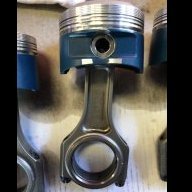Announcements
-
Similar Content
-
Latest Posts
-
Incidentally, I also put v3 of the tune on the car and did an oil change from 5w20 to 5w40 to see how it affected oil pressure in the mid to high end. I'm still happier with the thicker oil and will stick with it, but clearly the system is happy with 55psi even if I'm not!
-
So the other thing I got sorted over the weekend was Z1 oil catch can install. https://www.z1motorsports.com/z1-products/z1-motorsports/z1-q50-q60-30t-baffled-oil-catch-can-kit-p-23546.html It was a good kit, most importantly it came with preformed silicone hoses in the right shapes rather than trying to bend/join regular straight rubber hose. It did come with crappy spring clamps not proper hose clamps so I ditched them On the down side, it is made for LHD cars and RHD cars have the main ECU harness running straight through that location, I ended up bending 2 mounting brackets so the loom is up against the brake master cylinder compartment wall to make room for it....otherwise everything fit without modification Intercoolers off on both sides, but there was enough room to get everything done without disconnecting (and therefore having to re-bleed) the coolant lines. Each is mounted with 4x 12mm headed bolts, plus in and out side hose clamps (7mm headed, nice) and 3 electrical connectors on the navigator's side which were a real pain to undo (probably for the first time in 13 years). Also one of the mounting bolts on the driver's side was cross threaded, thanks Infiniti/Nissan workshop mechanics. On the navigator's side, the catch can plumbs into the factory hose that goes from the cam cover PCV back to the intake. This is the 2 new hoses in place. All simples and direct fit On driver's side, there is a bracket provided that mounts to the throttle body, they even provide slightly longer bolts to allow for the bracket thickness which is nice (although, they don't have captive washers like the factory bolts of course) In that pic the main loom brackets are not in place, once I had "adjusted" them across it now sits up against the panel and just clears the OCC The remaining problem with this is emptying it; currently you have to remove the 3x m4 bolts that hold it to the bracket and both banjos to remove it (probably dropping the banjo washers at the same time) pull it apart to empty then replace. I do have some fittings coming for a remote drain from underneath that will also add a little capacity...it is very small and will need to be emptied every oil change to be sure.
-
Noise sounds to me could be either wheel bearing related (have had similar from bearings going) or that tail shaft is still loose. Or something like a heat shield touching the tail shaft.
-
You wouldn't get away with saying the opposite, if you were there.
-





Recommended Posts
Create an account or sign in to comment
You need to be a member in order to leave a comment
Create an account
Sign up for a new account in our community. It's easy!
Register a new accountSign in
Already have an account? Sign in here.
Sign In Now